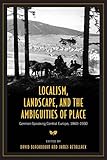Localism, Landscape, and the Ambiguities of Place : German-Speaking Central Europe, 1860-1930 / ed. by David Blackbourn, James Retallack.
Material type: TextSeries: German and European StudiesPublisher: Toronto : University of Toronto Press, [2007]Copyright date: ©2007Description: 1 online resource (320 p.)Content type:
TextSeries: German and European StudiesPublisher: Toronto : University of Toronto Press, [2007]Copyright date: ©2007Description: 1 online resource (320 p.)Content type: - 9780802093189
- 9781442684522
- 943.08
- DD220
- online - DeGruyter
| Item type | Current library | Call number | URL | Status | Notes | Barcode | |
|---|---|---|---|---|---|---|---|
 eBook
eBook
|
Biblioteca "Angelicum" Pont. Univ. S.Tommaso d'Aquino Nuvola online | online - DeGruyter (Browse shelf(Opens below)) | Online access | Not for loan (Accesso limitato) | Accesso per gli utenti autorizzati / Access for authorized users | (dgr)9781442684522 |
Browsing Biblioteca "Angelicum" Pont. Univ. S.Tommaso d'Aquino shelves, Shelving location: Nuvola online Close shelf browser (Hides shelf browser)

|

|

|

|

|

|

|
||
| online - DeGruyter Las Mocedades De Rodrigo : The Youthful Deeds of Rodrigo, the Cid / | online - DeGruyter Learning Civil Societies : Shifting Contexts for Democratic Planning and Governance / | online - DeGruyter Literary Celebrity in Canada / | online - DeGruyter Localism, Landscape, and the Ambiguities of Place : German-Speaking Central Europe, 1860-1930 / | online - DeGruyter Madness and the Mad in Russian Culture / | online - DeGruyter Marginal Man : The Dark Vision of Harold Innis / | online - DeGruyter Max Weber's 'Objectivity' Reconsidered / |
restricted access online access with authorization star
http://purl.org/coar/access_right/c_16ec
What makes a person call a particular place ?home?? Does it follow simply from being born there? Is it the result of a language shared with neighbours or attachment to a familiar landscape? Perhaps it is a piece of music, or a painting, or even a travelogue that captures the essence of home. And what about the sense of belonging that inspires nationalist or local autonomy movements? Each of these can be a marker of identity, but all are ambiguous. Where you were born has a different meaning if, like so many modern Germans, you have moved on and now live elsewhere. Representing the ?national interest? in parliament becomes more difficult when voters demand attention to local and regional issues or when ethnic tensions erupt. In all these situations the landscape of ?home? takes on a more elusive meaning.Localism, Landscape, and the Ambiguities of Place is about the German nation state and the German-speaking lands beyond it, from the 1860s to the 1930s. The authors explore a wide range of subjects: music and art, elections and political festivities, local landscape and nature conservation, tourism and language struggles in the family and the school. Yet they share an interest in the ambiguities of German identity in an age of extraordinarily rapid socio-economic change. These essays do not assume the primacy of national allegiance. Instead, by using the ?sense of place? as a prism to look at German identity in new ways, they examine a sense of ?Germanness? that was neither self-evident nor unchanging.
Mode of access: Internet via World Wide Web.
In English.
Description based on online resource; title from PDF title page (publisher's Web site, viewed 01. Nov 2023)


